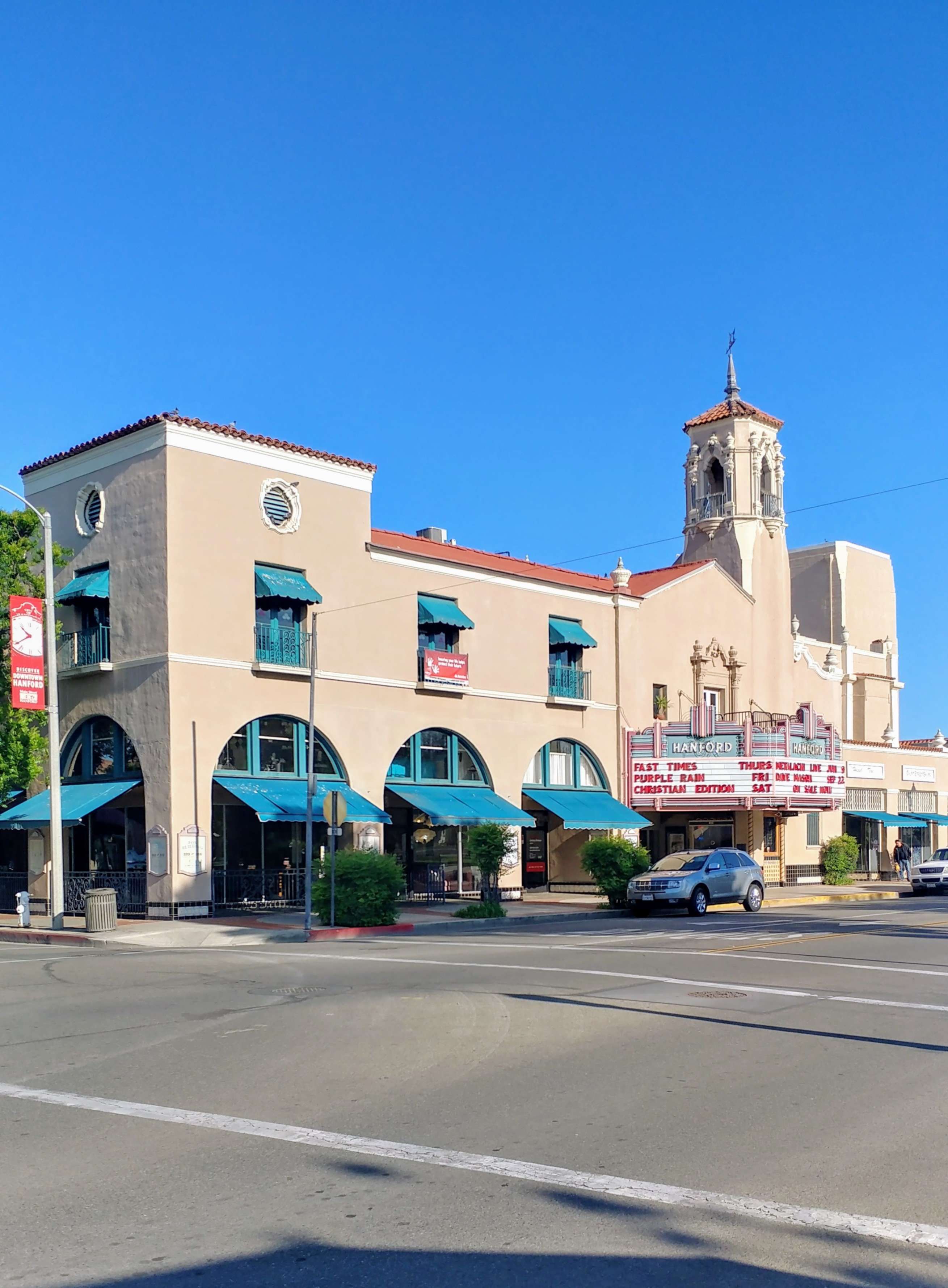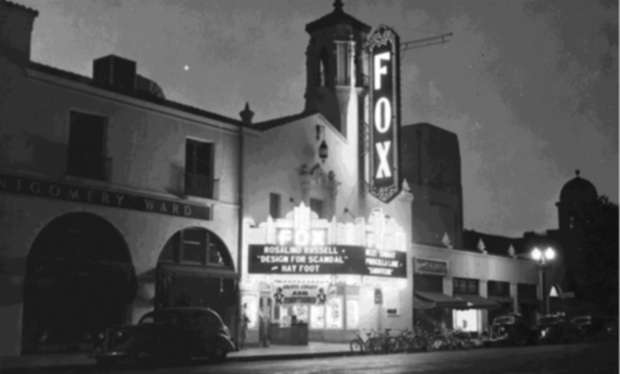About The Historic Hanford Fox Theatre
A small history of early theatre palaces in the United States which includes the Historic Hanford Fox Theatre, one of the few remaining still in operation and fully restored to its 1929 elegance. No buildings in America have been, collectively, as audaciously romantic, blatantly derivative, and wonderfully original as the movie palaces. The majority of these palaces were built during the years between World War I and the Great Depression. Nationwide, even the smallest towns could boast regally outfitted movie houses. The theaters ranged in style from bewilderingly eclectic to near-perfect replicas of the finest royal palaces of Europe and the Orient. The patrons were not always aware of the decorations' origins, but they flocked to see whatever spectacular arrangements the palaces architects dreamed up. Moviegoers in the 30's and 40's were able to witness happenings from all over the world. Lacking the immediacy of television and radio in it's infancy, the significance of the movie palace is difficult to appreciate. More than just the primary source of entertainment, the theaters were the local gathering spots, the centers of downtown night life. Integrating all classes and levels of society. The movies provided a release for the increasing pressures of a world growing more hectic by the day. A ticket to a show was a passport to lives and cultures otherwise beyond reach. No form of entertainment had ever been as accessible or as popular. The opening of a new movie theatre in town was cause for public celebration, with all the hoopla normally reserved for a major movie premiere. Even in Hanford, front page coverage of the December 1929 Grand Opening of The Fox dominated the Christmas holiday news. Built by William Fox of Fox Theaters in 1929, and one of 900+ across the United States, the Hanford Fox Theatre is designed as an atmospheric theatre. This type of theatre, as opposed to the ornate or art deco style, is designed to create the illusion of being located in a romantic far-off place. The locale is a Spanish courtyard, complete with twinkling stars and crescent moon in a dark night sky. There are tile covered buildings with lighted windows, balconies and turrets, silhouetted and backlighted by the glow of a village beyond. In the shadows rise mountains covered with cypress and palm trees. Greco-Roman columns support the proscenium. Further back are Mediteranian and Spanish renaissance influences, but the over all decor is Mission Revival. Very eclectic, yet appropriate. Each theatre was required to have a fire-proof screen to separate backstage from the audience. The architects designed them to be painted with a large mural incorporating the theme of the auditorium. The Hanford Theatre's screen depicts a Spanish village with church bell tower, cypress trees, and terra cotta roofed buildings. It is a magnificent oil painting filling the entire stage opening. The designers of the early theatres included a full stage, dressing rooms, flyand orchestra pit in their plans, because vaudeville was still very much in vogue and movies had not dominated the entertainment scene. Traveling troupes crises-crossed the United States exhibiting their acts for an entertainment starved nation. Then, the genius of the motion picture pioneers developed a frame-lined celluloid film and put pictures into motion. William Fox himself, viewed the moving picture flicks as a passing fad. But the publics interest was caught and their fascination grew. Vaudeville soon shared the stage with the movie screen. Acts such as Laurel and Hardy bowed to curtain calls as they visited the theatres during a premiere of their latest film. A new industry developed rapidly, as people swarmed into the theatres. The orchestra pits were used to provide space for full orchestras, and later it housed a pipe organ console. The Hanford Fox had these facilities and pipe organ music was a normal form of music appreciation for the audience to enjoy during silent films or intermission music. Orchestra music was used when live stage events occurred. Just as movies supplanted vaudeville in popularity after World War I, television in everyone's living room reduced box office admissions dramatically after World War II. To cope economically, the movie houses and palaces were torn down, or altered for other uses. Some were twinned or triplexed (the interiors converted to several theatres), thus destroying the priceless architectural designs. This was done to be more competitive with the trend toward multi-screen complexes; the more screens, the better able to contract new films, and the more choice for the public. Smaller movie houses resulted in poor design, smaller screens, and poor sound. There are some happy endings or more precisely, new beginnings to the story. Many of the old palaces have been reincarnated as homes for a variety of operations. Taking full advantages of the second chance, the proprietors of the restored theatres have thrown open the doors once again to amaze a new generation of spectators and to stir the memories of those who can still recall a time when movies cost a quarter and the theatres alone were worth the price of admission. 54 years after its Grand Opening, tired and about to be divided into shoe box and XXX theatres, this building was purchased by historic preservationist J. Daniel Humason in 1979. Together with his family they reopened the theatre for movies in 1982, soon after the Theatre hosted its first live concert since the old days. The Hanford Fox Theatre awoke from her slumber and entertained once again. The stage continues to exhibit live entertainers. Silent films and movies are still shown during special times, benefits, and film festivals. The restored 1929 Historic Hanford Fox Theatre, with its 889 seats downstairs, is the largest sloped-floor auditorium in Kings County. The balcony, originally with 350 seats, now has 142 plush rocking chairs and snacks, soft drinks, beer & wine (ages 21 and over) are served. It is appropriately named the Cabaret. Operating a privately owned theater is a labor of love, time and personal energy. Restoration is an ongoing process, and we enjoy sharing the experiences with others. In order for this theatre to pay its way we feel that commercialism is the servant of preservation, not the other way around. We rent the theatre to private parties, schools, churches, hospitals, charities, business, industrial groups, unions, and governmental organizations alike. We have even been host to weddings in the picturesque auditorium. We are making progress, however we still have a way to go and need the support and concern of many. The Fox has had quite a colorful background, steeped in American history. It has made a full circle from the 20's vaudeville silent film, early talkiesthroughout the prime years when movies were the center of entertainment. It has survived the transition of TV and the subsequent phase of multi-screensor other adaptive uses. An architectural treasure designed for multiple uses, hosting community and cultural events. Much more can be said about this Fox Theatre, which we leave for you to discover. We hope you take the time to visit and attend performances and movies at the Historic Hanford Fox Theatre. We welcome your comments ideas and suggestions. Additionally, we look forward to providing you, the guest of the theatre with quality entertainment. Above all, we look forward to seeing and serving you at the Theatre!



